
Let’s play a game. Can you tell me the prospecting definition without looking it up?
Now, ask your colleague the same question and compare your answers.
We bet that the two will be completely different, and both will be off the mark. Prospecting takes up a huge chunk of a sales representative’s time, and yet narrowing down a clear concise definition for it is hard.
By our estimate, in the U.S. alone people look up ‘sales prospecting definition’ more than 25,000 times per month. And I don’t blame them. Different companies define prospecting in different ways, and for newcomers to sales it can be challenging to understand exactly what it means.

(Source: Ahrefs)
And you’d be mistaken to think that the question of ‘what is sales prospecting’ is relevant only to newcomers.
A poor definition of prospecting can impact how you approach to your sales strategy, and can even impede your team’s results in the long term.
That’s why we decided to nail the perfect definition of sales prospecting. And we hope that this definition helps your team better understand how to move towards their sales goals.
Let’s begin with what started us down this road — the question of why it’s so hard to define prospecting.
Why it’s so hard to find the right definition for sales prospecting
Imagine that you’re a sales newbie. What do you do when you first encounter the term ‘prospecting’? You search for it on Google.
The dictionary card that greets you doesn’t exactly make things any clearer:
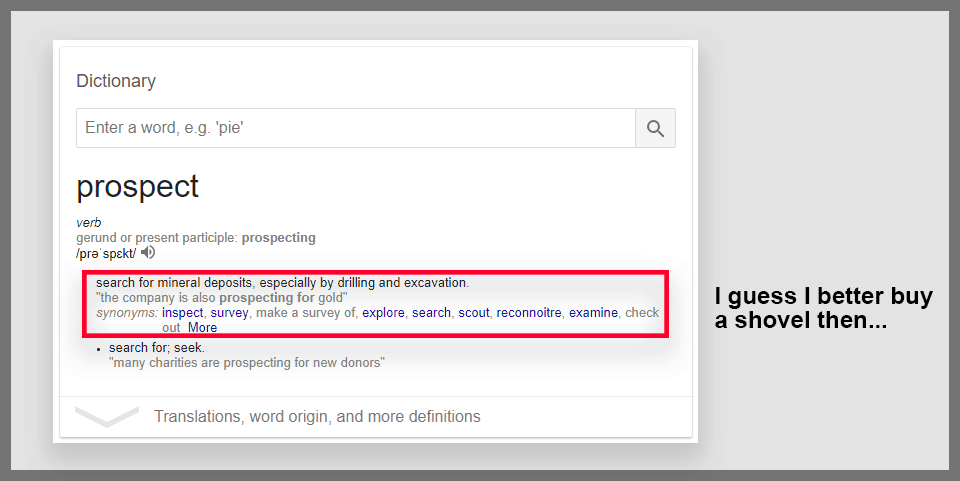
Searching for mineral deposits?
Prospecting for gold? Should I buy a shovel?
The vocabulary definition of ‘prospecting’ doesn’t have much in common with sales prospecting. But as a metaphor, it keeps us on the right track. Sales prospecting is connected to searching for gold — but we’re not talking about the precious metal, we’re talking key accounts and customers so that your company can maximize growth.
What makes narrowing down sales prospecting so hard is that it’s abstract and concrete at the same time. On the abstract level, we define the concept of prospecting as searching for potential customers.
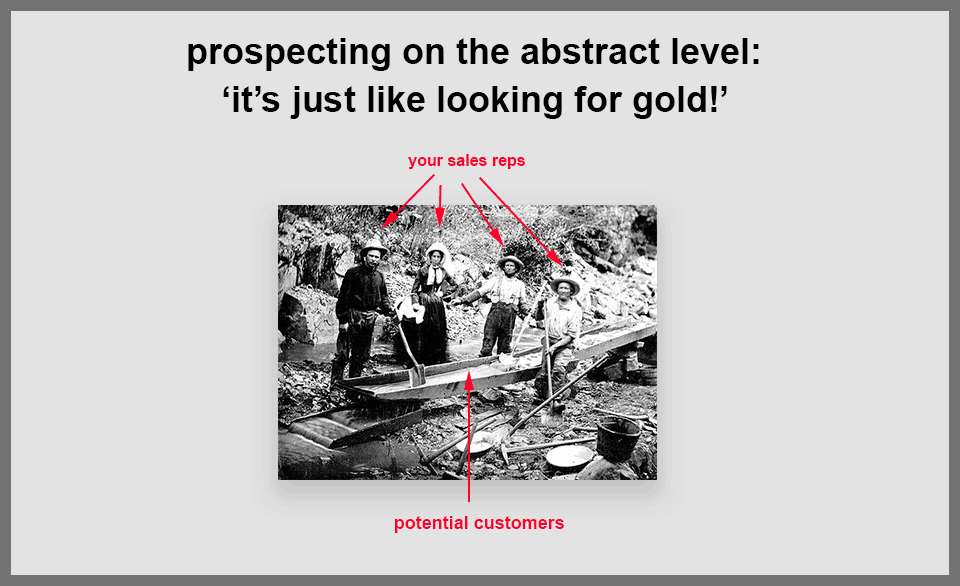
On the practical level, searching for customers is one aspect of sales prospecting.
Besides, many prospecting tools and techniques overlap with marketing or lead generation. It’s imperative not to mix them up.
What I’ve found while looking up existing definitions of prospecting is that they are often too narrow or too broad. Some of those make it infuriating to try understanding what tasks or activities sales prospecting consists of.
For example, RingDNA’s definition for sales prospecting breaks it down as “making outbound calls or sending outbound emails to leads in hopes of creating opportunities for account executives”.
Which is all good, but what if I want to contact people via social media? Or other channels?
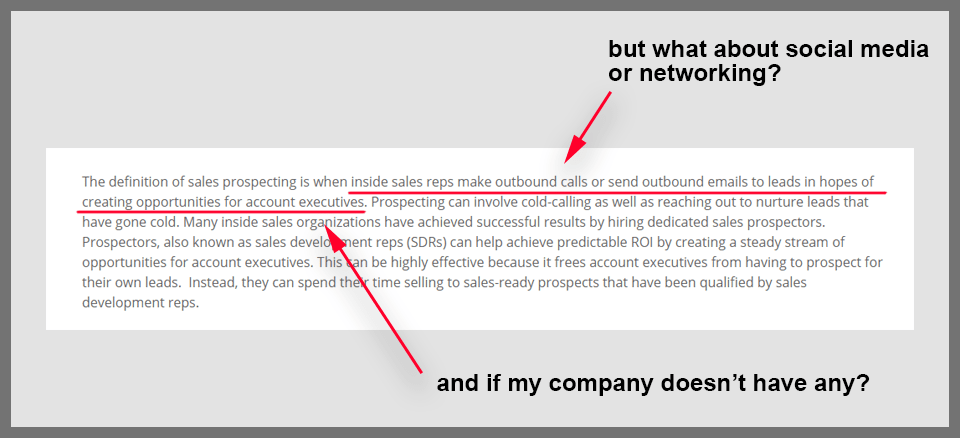
Reference’s definition is good but too broad. It defines prospecting as “the act of recruiting or seeking out new customers for a business […] associated with a goal of increasing the customer base of the company and generating new revenue streams”.
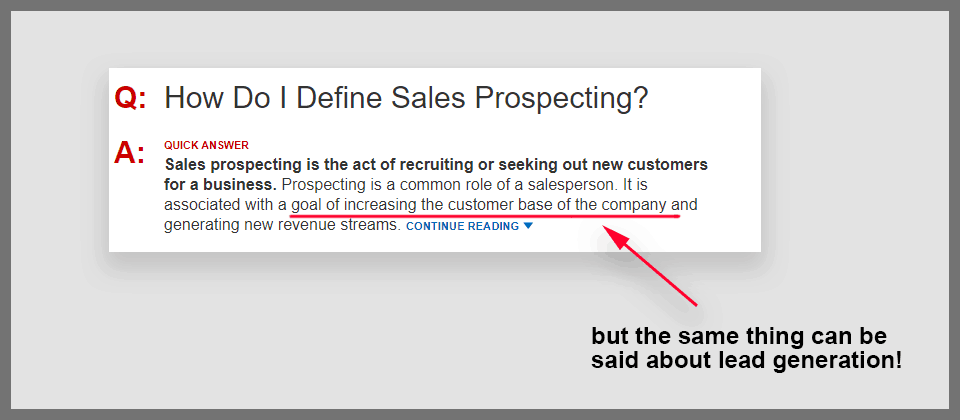
Once again, it’s not wrong, but it doesn’t help me understand what prospecting actually is. Is prospecting something I do regularly or once? What tools should I use?
Leadfuze comes pretty close to a thorough definition of sales prospecting. Their article on the topic says that “when you start a sales prospecting session, you have no leads nor contact data. When you’re finished with that session, you have leads and contact data.”
Which sounds great! But once again, it doesn’t tell us what prospecting should consist of. Or where it begins and where it ends.
The definition of prospecting
After vigorously scavenging the internet for different definitions of sales prospecting, I’m pretty confident to say that I’ve got a very accurate (maybe the best) one.
Ready?
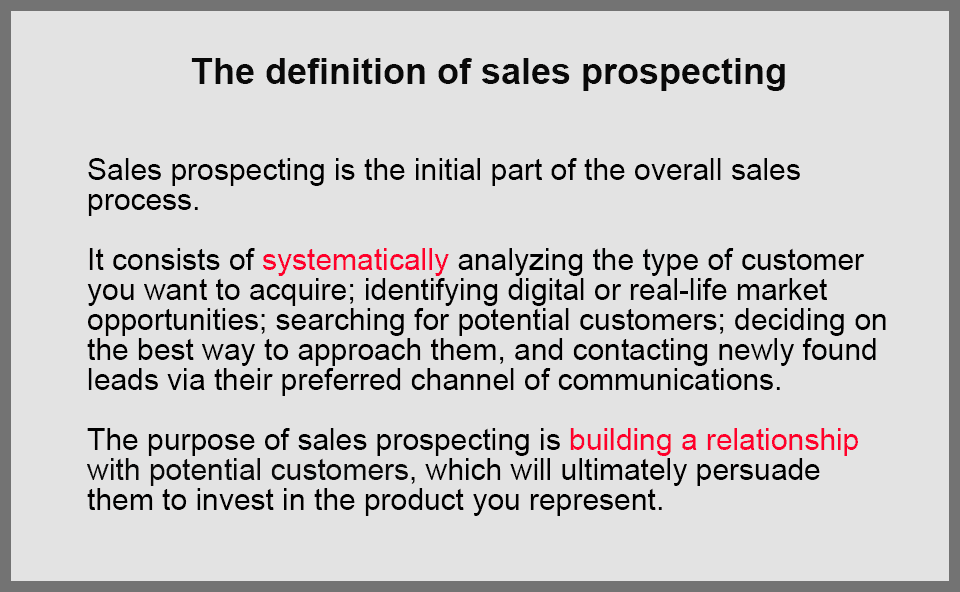
I’m happy with this definition. It nails down important aspects of what prospecting is that other definitions skip.
For instance, it mentions that sales prospecting is systematic. This means that it’s a process that should be recurring in your sales strategy. It’s not something you do once and then forget about.
Our definition also makes it clear that the ultimate purpose of prospecting isn’t pitching. Instead, it’s all about building a relationship with potential customers.
This part is essential to a solid approach to prospecting. Skipping on relationship-building means not taking full advantage of cold emails down the road. This will naturally hurt your chances to secure a deal.
What are those techniques? And while we’re at it, what makes each aspect of sales prospecting different? Let’s see what prospecting is made of.
8 steps of great sales prospecting
Each company has its own approach to prospecting.
Some rely on LinkedIn and cold emails. Others are all about purchased lists and cold calls. Some perform prospecting initiatives once a quarter. Others approach it as a recurring daily task…and so on.
But it doesn’t matter what variation of prospecting your company is using. We can distill what makes for great sales prospecting into eight steps.
Here they are:
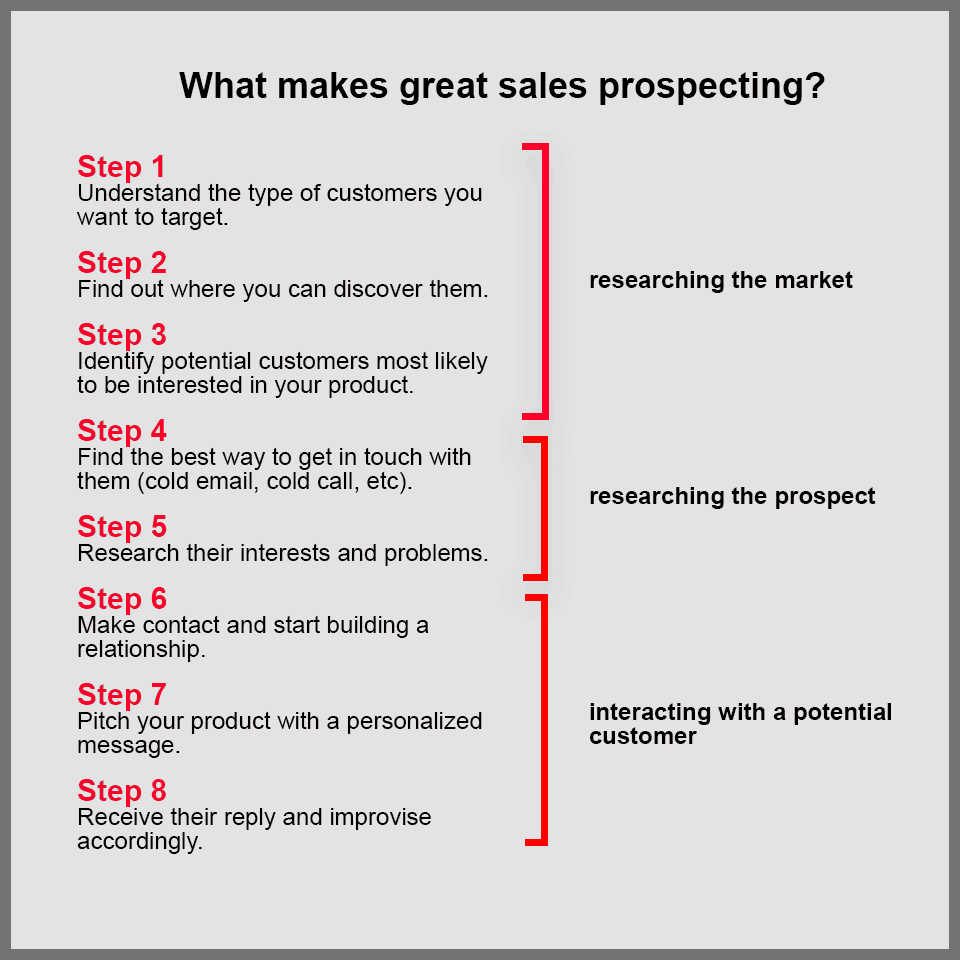
These 8 steps represent a checklist for perfect sales prospecting. The more steps you execute, the better your prospecting is. The better your prospecting is, the more customers you’ll bring on board.
Let’s break each step down:
1. Understand the type of customers you want to target
This is the point from which you start prospecting. The best tactic at this point is to build an ideal customer profile. Our guide to a perfect sales strategy explains how to identify your ideal customer profile in more detail.
2. Find out where you can discover them
Select appropriate channels for your prospecting efforts based on your ideal customer profile. If you’re selling to people who work at bigger companies, you’re probably going to want to take a look at their company profiles. If you’re selling to bloggers or freelancers, start performing Google searches to find out where they’ve been published, and get a better understanding of their web presence.
3. Identify potential customers most likely to be interested in your product
Start making lists of leads you will contact. Sales Navigator is one of the best tools that can help you with this process. Get acquainted with all the shortcuts to using it the smart way.
4. Find the best way to get in touch with them (cold email, cold call, etc)
Some leads will be best contacted by a cold email, while others prefer a cold call, and some need a nudge on social media. Tools like LeadGibbon help you find and verify email addresses. Take a look at your prospect’s personal website and social media profiles to find clues to how they prefer to be contacted.

5. Research their interests and problems
It’s important to understand what kind of message your prospect wants to hear. Research the tools they are using, their previous experience, the articles they have published, etc.
6. Make contact and start building a relationship
Engage potential customers in a discussion on Twitter. Write a cold email that doesn’t sell. Make a connection through a common acquaintance.
Having an existing positive relationship will make it far more likely that the prospect responds when it’s time to give them your pitch.

(Source: Databox)
7. Pitch your product with a personalized message
Feel that your prospect is sufficiently warmed up? Use your research to create a personalized, on-target pitch. The pitch should not tell your prospect how amazing your company is. Instead, it should convey to your prospects how your product is going to help them solve a problem.
And pay attention to your cold email subject lines – if you don’t want your emails to stay cold forever.
8. Understand their response and improvise accordingly
Nobody knows how your prospect is going to respond. Maybe they are interested and you’ll schedule a meeting. Maybe they will demand more details before making a decision. Or maybe they will outright reject you. Nevertheless, this step marks a point where prospecting ends — and selling begins.

The difference between prospecting and marketing/lead generation
Here’s what I’ve encountered when researching for this article. There is a lot of confusion between prospecting and lead generation.
On the surface, these two concepts do seem interchangeable. Both of them have the same goal – attracting customers. But if we look closer, there is a very important difference between the two.
This difference can impact the performance of your company and the distribution of roles within your team. Here’s that difference in a nutshell:
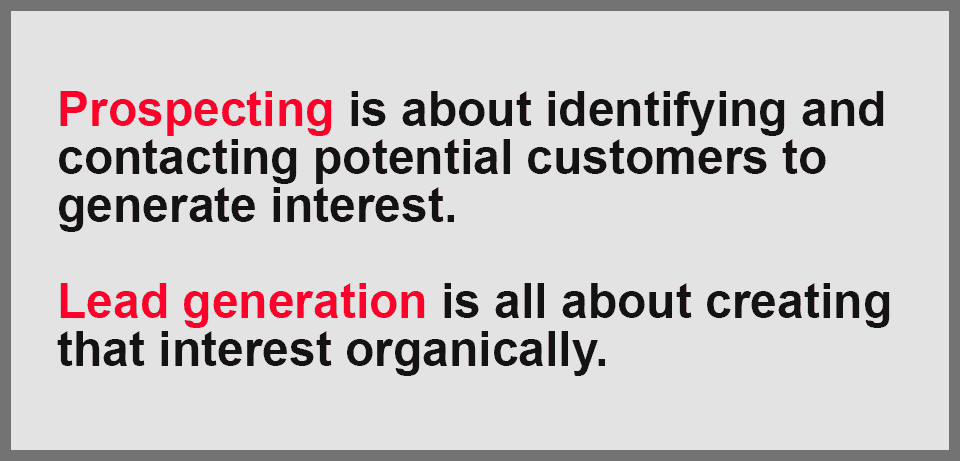
The end goal of lead generation is creating a pipeline through which potential customers will encounter your product, become interested and contact your company (by signing up for a trial, for example) all on their own.
This means that lead generation falls within the jurisdiction of your marketing department. Marketers create content, write copy and use other methods to attract potential customers to your company.
Prospecting, on the other hand, is all about seeking out IDEAL prospects and contacting them proactively.

So where’s the confusion coming from?
In smaller companies, the roles of sales reps and marketers often overlap. Sometimes both prospecting and lead generation are tasks of the same team.
But as a company grows, this approach can lead to miscommunication and confusion. Lead generation is great for attracting customers in the long-term. Prospecting is more about immediate actions and immediate gains.
Creating organic interest from customers sounds cool. But if your company decides to invest in the wrong strategy during its initial stages, it risks misallocating its resources and failing to hit its targets.
Though different, not understanding that prospecting and lead generation are closely related is another common mistake. Sales reps will benefit greatly from resources produced by their marketing department to convert prospects into leads (for example White papers, Ebooks, Case studies, etc. can be shared with prospects to strengthen the pitch).
And successful prospecting leads to more data about the customers you’re trying to bring on board. Marketers can use this to their advantage to identify the best content for the prospects you’re targeting. This creates a strong feedback loop between marketing and sales. One that should never be broken.
Conclusions
Approaching prospecting as a recurring, multi-step process will help you build a more solid sales strategy. We hope that this article helps you better understand what sales prospecting actually is.
Do you agree with our definition of sales prospecting? Or do you have some thoughts on how to improve it? Then leave a comment below!

These tips you provided are really helpful. I agree that prospecting is essential in sales. Finding possible leads is one of the most difficult tasks, that is unless you are organized and goal-driven. Making use of social media is also important since most people are socially active on platforms such as Facebook, Twitter, and LinkedIn.